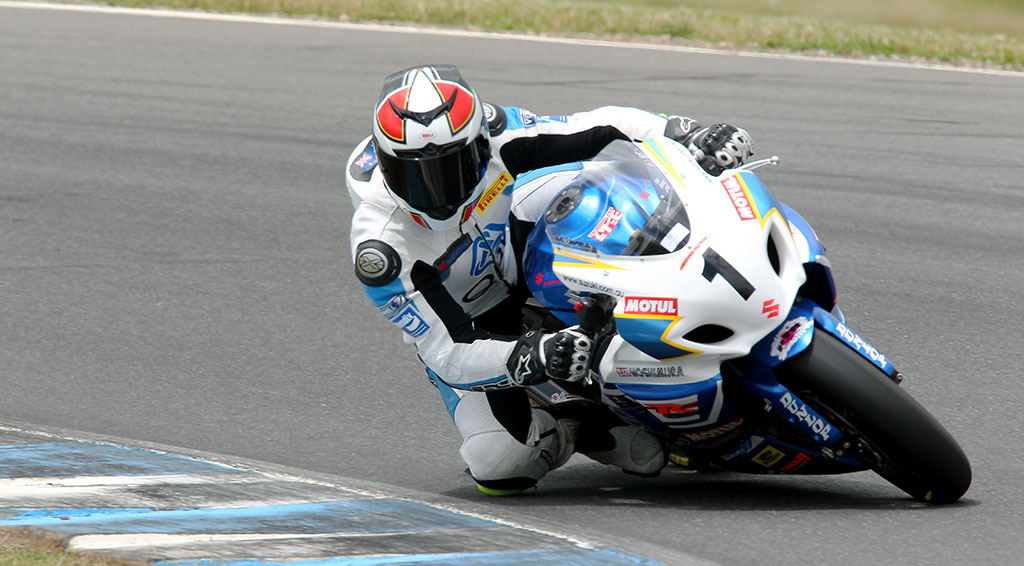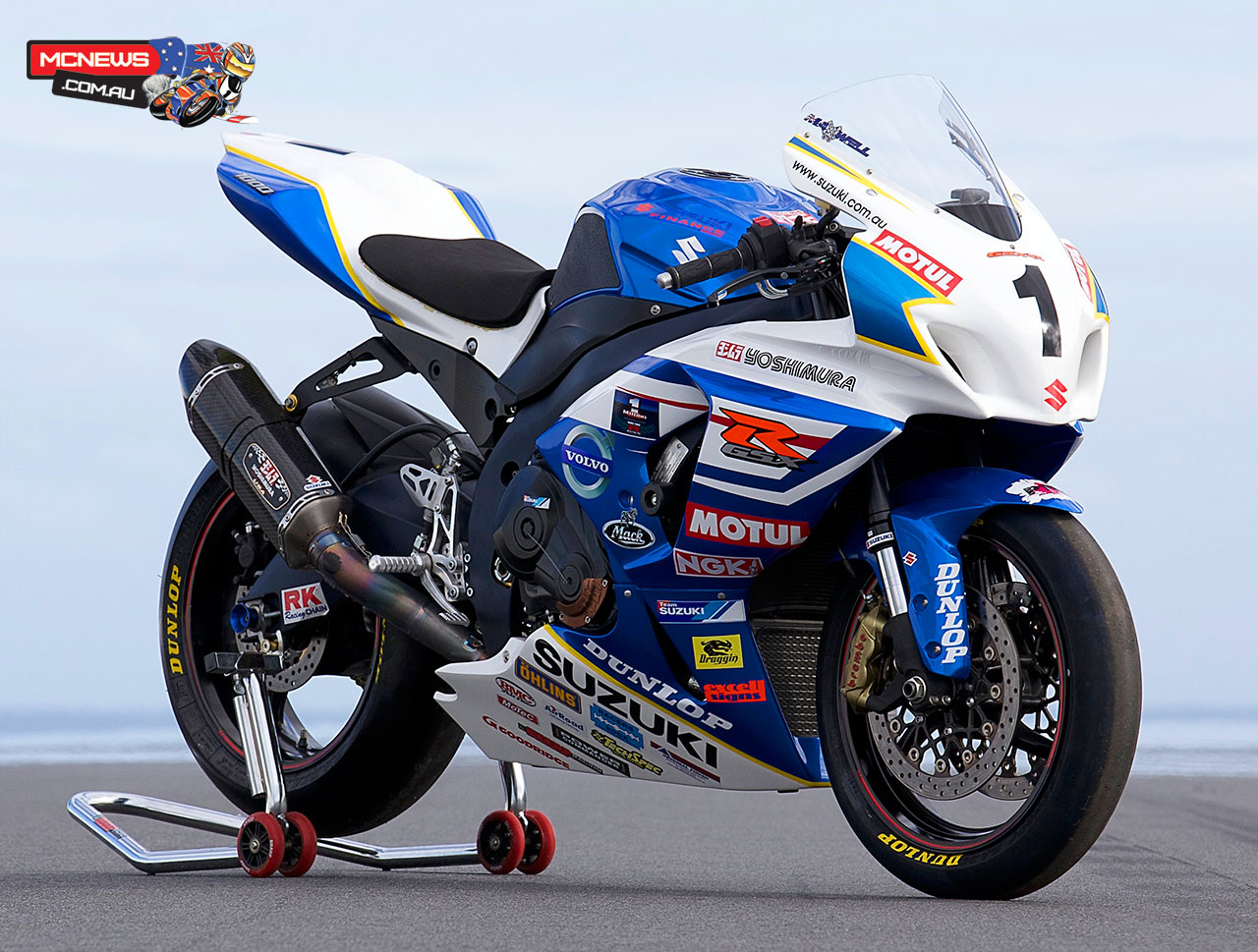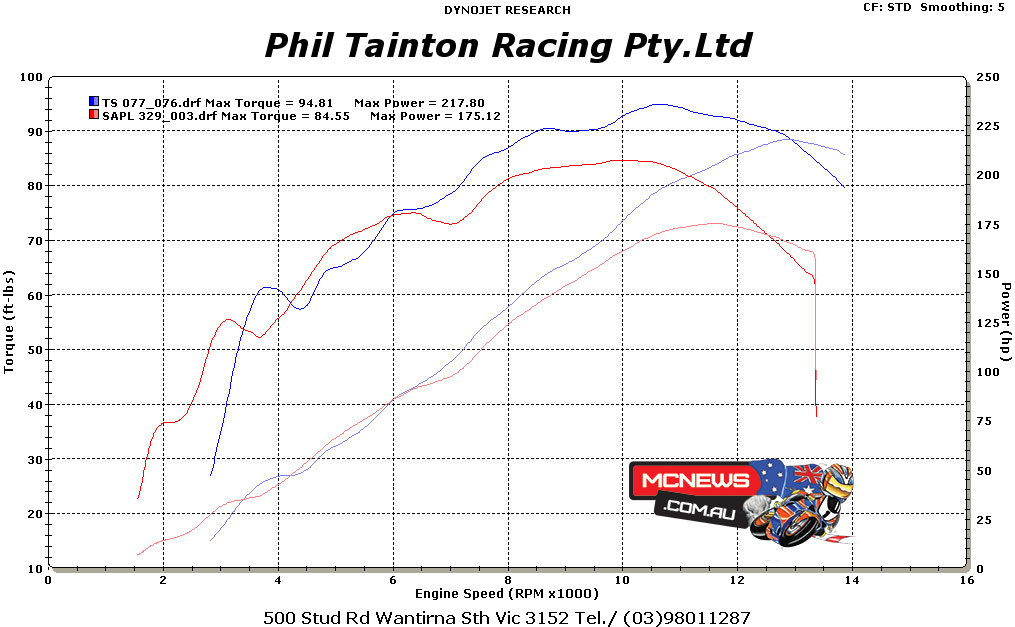ASBK 2013 Championship winning Suzuki GSX-R1000
Tested by Steve Martin for MCNews.com.au at Phillip Island – The bike Wayne Maxwell rode to the Title

Wow how time flies… It was last century, 1999 to be precise, when I last got to throw a leg over a championship winning ASBK specifications Superbike and that bike, – my own 996 Ducati no less – was a very special machine.
Fast forward a few years…. early last week I was very happy to get the call from MCNews.com.au with an invitation via Suzuki Australia, to ride Wayne Maxwell’s Australian Championship winning GSX-R1000, complete with the exact same set-up it came off the track with after the final round of the season at Phillip Island.
Over the years, I have been lucky enough via my involvement with the Superbike World Championship, to ride a multitude of full-blown World Superbikes, complete with ‘unobtanium’ factory kit parts. World Superbike specification machines are significantly different to Australian Superbikes due to variances in the rules. Thus, the opportunity to sample a current Australian spec Superbike had me very intrigued.
In typical Phillip Island summer fashion it rained on the morning of the test, so we had plenty of time to have a close look over the GSX-R that Phil Tainton from PTR has been preparing for Suzuki every year since 1996.
As a race bike the GSX-R is virtually the same as the 2012 model, which isn’t a bad thing as Josh Waters piloted it to the championship title that year. Apart from the usual tweaking that tuners continuously do, the biggest difference between the two championship models has actually been the ergonomics and the set-up to suit Wayne’s style.
Josh liked the bike set up to be more nose heavy which made the Suzuki very nimble. One negative in a nose heavy bike is that it has less steering trail. Set up that way, Wayne struggled to get comfortable with the front end feel. As Phil and Wayne got to know each other and build up trust, they started to take the weight off the front end by stiffening springs, adding preload and changing ride height. This flattened the bike out and gave Wayne the confidence he needed to win the championship by 21-points ahead of BMW’s Glenn Allerton and Wayne’s own team-mate at Suzuki, Robbie Bugden.
The standard GSX-R is a beautiful road bike and it’s no slouch either. 175 rear wheel horse power and 203 real kilograms are its stats but when you compare those figures to the 218 HP and 174 kg of the race bike you start to understand that the Superbike version is a serious piece of kit. To strip 29 kilograms off of a bike under the constraints of the Australian rules is amazing when you consider very little Titanium is allowed. Standard rims, triple clamps, forks and brakes must be maintained. This means Phil has spent countless hours scratching his head thinking of ways to save weight where he could. He uses a Super B battery which is a quarter the weight of the standard battery, lighter fairings and a very trick looking Titanium Yoshimura exhaust system, to knock a lot of the initial weight off; but it’s the small things like the PTR made footrests, hand crafted brackets and lighter braided brake lines that are a little harder to see, that knock the last hard few kilos off. The attention to detail even goes as far as milling a slot in the front brake lever so wind pressure doesn’t apply the brake at high speed.
The Suspension is not standard either. Ohlins 30mm cartridges are fitted to the standard front forks and a TTX Ohlins shock suspends the rear. Phil has been tuning suspension for more than 20 years so he is also responsible for maintenance and any fettling of the fork and shock that needs to be done internally. The rear ride height can be raised or lowered by the standard ride height adjuster, a very handy addition to any bike as it gives you a lot more chassis adjustability.
Phil was pretty proud to let us know that the bike we were riding on the day was the most powerful version that he had made yet and with 218 horsepower on tap I wasn’t about to argue with him. The engine has a magical 14.4 compression ratio which Phil says gives you best mid-range grunt without sacrificing top end power.
The cylinder head is modified by Phil to his own special specifications in his Wantirna South workshop and he ports every head by hand. Doing it by hand obviously is laborious but it is also a tribute to his attention to detail and if you have been around the racing paddock the smart people learn quickly that attention to detail is what wins races and championships. The camshafts were a new spec for 2013 and made by Yoshimura. They produce more power than the previous model but the revs have had to be reduced to a ceiling of 14,000 rpm from 14,300. The valves are standard as are the valve retainers, a great testament to the road bike internals. Phil can change the retainers if he wants to but there is no need as the standard ones are more than up to the job. The standard pistons are fly cut to suit the lift of the Yoshimura cams but everything under the pistons including rods crank gearbox and cases are completely standard to comply with the rules of ASBK.
Usually when tuners get those big horsepower figures, drivability of the engine suffers. It becomes peaky, loses mid-range and becomes a wheelie monster which is good to impress your mates but not so good if you’re trying to race for a championship. This was one aspect of the machine I was looking forward to assessing.
Brakes are standard front and rear with Phil having a multitude of pads to choose from depending on the rider feel required. The master cylinder is changed from the standard Nissan to a 19 mm Brembo item which boosts lever feel; lever feel is one of the most important aspects of trail braking in to any corner and that is why Phil has chosen not to be tied down to one partner in this area.
One of the biggest advancements in motorsports over the last decade has been in the electronic suites now on offer. Although the standard GSX-R doesn’t have traction control, Wayne’s race bike does. He uses a fully adjustable Yoshimura Em-Pro ECU with two different engine maps (one for dry and a softer one for wet), three different slip variations in traction control which can be changed on the fly, an adjustable gear specific engine brake assist and of course a simple pit lane speed limiter. The other really trick thing the Yoshimura ECU can do is alter the power output of each individual cylinder depending on throttle input and probably GPS and gear position. Phil was a little cagey on how it worked which means it obviously works so well he doesn’t want us to know exactly how. An example of what it could do though is to allow a peaky powerful engine to be smoothed out, which was something I was just about to find out as I was up.
Superbikes are always hard to assess when you ride them for one or two sessions because they are such an adjustable machine. You can get an impression but unless you spend a day setting the bike up to your needs (or get lucky to jump on a bike that is perfectly set to your liking), it’s difficult to comment too much about what the bike is or isn’t doing. That said, there is still a lot that you can feel and here’s my impression of my time aboard.
Heading out of the pit the first thing I noticed was how smooth the power was, the bike felt a lot like the GSX-R road bike. As I turned the pit limiter off and twisted the throttle things began to change quickly. This GSX-R has got some mumbo but it feels like a pussy cat. The power delivery is perfect in the way that it responds to throttle input. The engine doesn’t feel aggressive at all, it actually feels a little soft, which is exactly how you need it to feel if you want to look after your tyre and find grip off the turn.
The engine also felt very linear in the way it delivered its power, all the way to the 14,000rpm red line. My one criticism was the lack of smoothness from a completely closed throttle to the first crack, but benefit of the doubt and it goes back to what I was saying before: I think you could tune it out pretty easily. Top end power was great but obviously not quite as explosive as a full blown superbike, which is to be expected due to the constraints of the Australian rules.
The brakes were superb as expected with really good feel and in my opinion if they stay like they were for me at Wayne Train pace, all you need to do is keep putting pads in.
The standard Chassis is one of the strong points of the Suzuki as it’s very forgiving and it can work over a bigger adjustment range than some other race bikes out there. This is also the reason it took Phil and Wayne a little while to get to lap record pace as they ended up on a setting Phil hadn’t tried before.
Wayne likes his bike set up so he can be very aggressive on the brakes which means very hard in the front. Having a very hard front end at Phillip Island, means you have to commit to the fast corners and rear wheel steer through Southern Loop, Stoner and the Hayshed to stay on line. I’m the first guy to put my hand up and say I was riding with a lot of caution and therefore running wide. I reckon if I softened the front fork off I would be able to go a lot faster easier but then I’m not the guy doing 1m32s lap times…
Apart from running wide due to my lack of commitment, the Suzuki absorbed bumps beautifully and stayed glued to the road with the ASBK spec Dunlop slicks we had fitted.
I loved the Motec dash as it was really easy to read and the data logging system combined together is a great idea but it comes at a premium. The dash, logging system and sensors will set you back around $15,000. That sounds a lot but it goes back to that point I raised earlier, attention to detail is how you win races and the Motec system gives a very high quality data trace which lets Phil analyze the data quickly and efficiently.
The other nice touch was the gear shift cut sensor which allows you to keep the throttle pinned to the stop while tapping through the gear box.
At $42,000, ready to ride, excluding the Motec system, I think it would be hard to find a cheaper bike that is capable of doing a 1m32 lap time around Phillip Island. In a way, it’s a bit of a bargain if you want to race at the front. You could easily spend a lot more money buying building and developing a bike and not get near the bike this GSX-R is. I enjoyed my time aboard Wayne’s bike it’s just a pity I didn’t get to do as many laps as I liked, but Phil if you’re reading this, I’m free in January if you want to spend a day at the island..
PTR Suzuki GSX-R1000 – 2013 ASBK Championship winning bike as ridden by Wayne Maxwell
| PTR ASBK Suzuki GSX-R1000 Specifications | |
| Engine | 999cm3, Liquid -cooled, 4-cylinder, 4-stroke, 16-valve, DOHC |
| Head | PTR ported and machined |
| Camshafts | Yoshimura -Fujio’s latest design |
| Cylinder & Pistons | Production Suzuki |
| Valves | Production Suzuki with Yoshimura Valve Springs |
| Crank | Production |
| Transmission | 6 speed production |
| Clutch | Production Suzuki with Yoshimura plates & springs |
| Fuel Injection | Standard |
| Ignition/Electronics | Yoshimura Em-Pro adjustable ECU with adjustable engine braking & traction control + Dynojet Quick-shifter |
| Spark plug | NGK R0045Q |
| Exhaust | Yoshimura R-77 4-into-1 Titanium/Carbon Full System |
| Air Filter | BMC Race Filter |
| Lubricants | Motul 300V 10w60 |
| Tyres | Dunlop UK 919 Rear Slick, UK302 Front Slick |
| Rims/Wheels/Axles | Production Suzuki |
| Brake Discs | Production Suzuki |
| Brake Pads | Production Suzuki |
| Brake Calipers | Production Suzuki |
| Master Cylinders | Front: Brembo 19RCS Rear: Production Suzuki |
| Brake Hoses | Goodridge |
| Front Suspension | Production Suzuki with OHLINS FGR 171 Cartridge Kit |
| Rear Suspension | Ohlins TTX Rear Shock |
| Linkage | Production Suzuki |
| Rear Sets | PTR Adjustable Rear Sets |
| Fairings & Screen | Racers Edge |
| Chain | RK 520 |
| Engine Protection | Yoshimura |
| Graphics/Decals | Excell Signs |
| Measured Power | 218 hp (160kW) @ rear wheel @ 13,200 RPM |
| Torque | 93.5 ft/lb (126.5nm) @ rear wheel @ 10,800 RPM |
| Top Speed | 300 + KPH (depending on final drive ratio) |
| 2013 Phillip | Support Race -1m32.80 lap |
| 2012 Phillip Island Top Sped | Max Speed 297 km/h |
| 2012 Hidden Top Speed | 286kph -2013: 294 km/h |
| Weight | 174 kg |
| 2013 | ASBK Championship Winning Machine |
| Race Wins | 9 |
| Podiums | 23 |
| Lap Records | |
| Sydney Motorsport Park | Circuit Record 1m29.842 (R.Bugden) |
| Sydney Motorsport Park | Sydney Motorsport Park – Race Lap Record 1m30.445 (R.Bugden) |
| Hidden Valley | Hidden Valley -Circuit Best Lap 1m06.997 (W.Maxwell) |
| Phillip Island | 1m32.274 (W.Maxwell) |
| (The first bikes ever to dip below 1m29’s both Wayne’s & Robbies GSX-R1000s are the fastest bikes ever around Sydney Motorsport Park circuit) | |










































